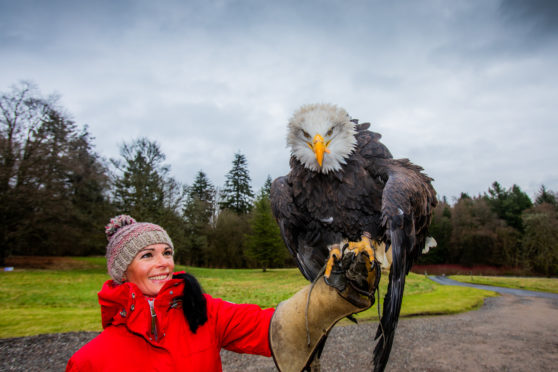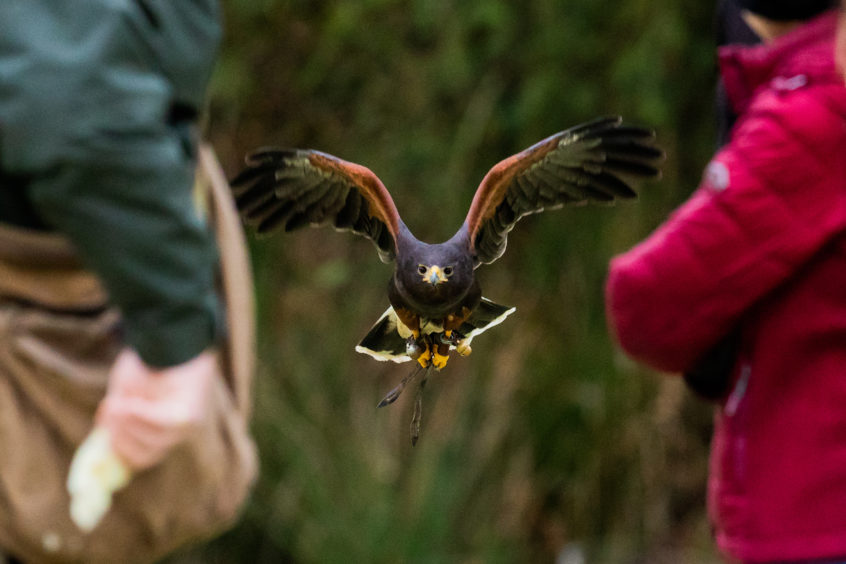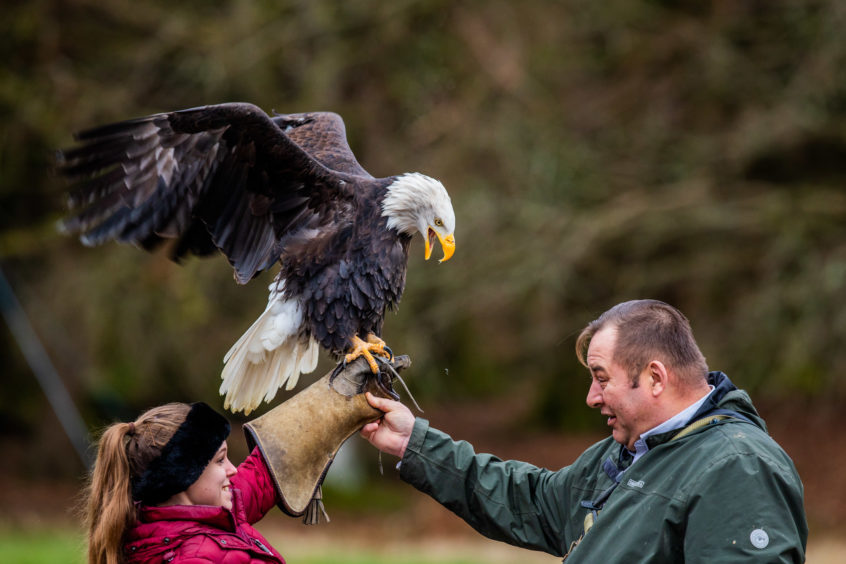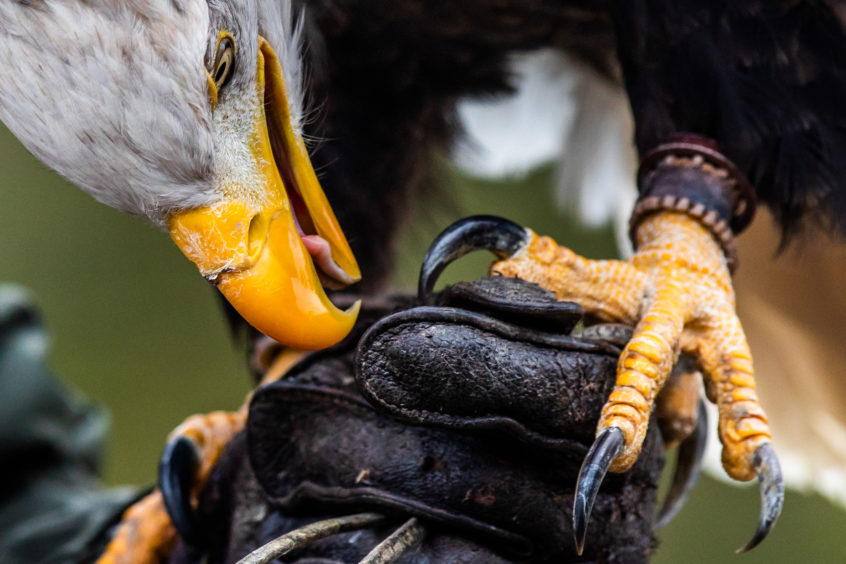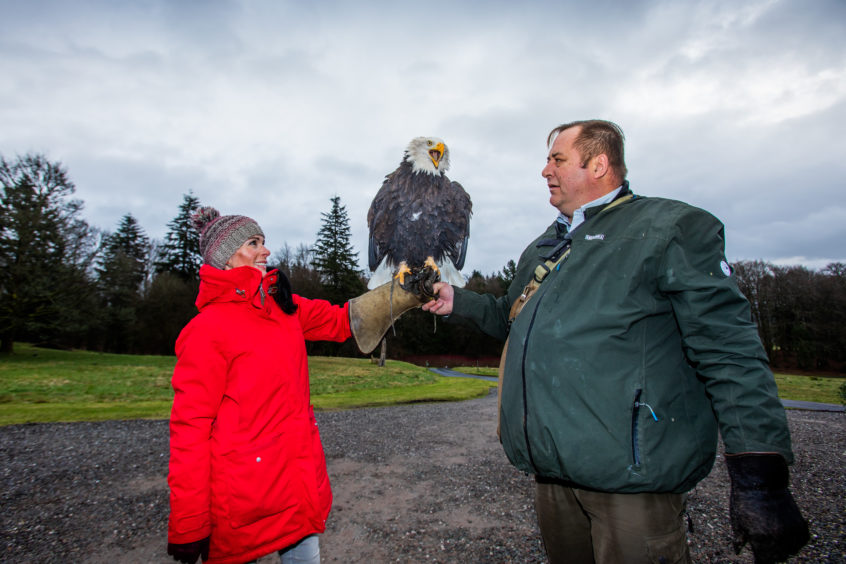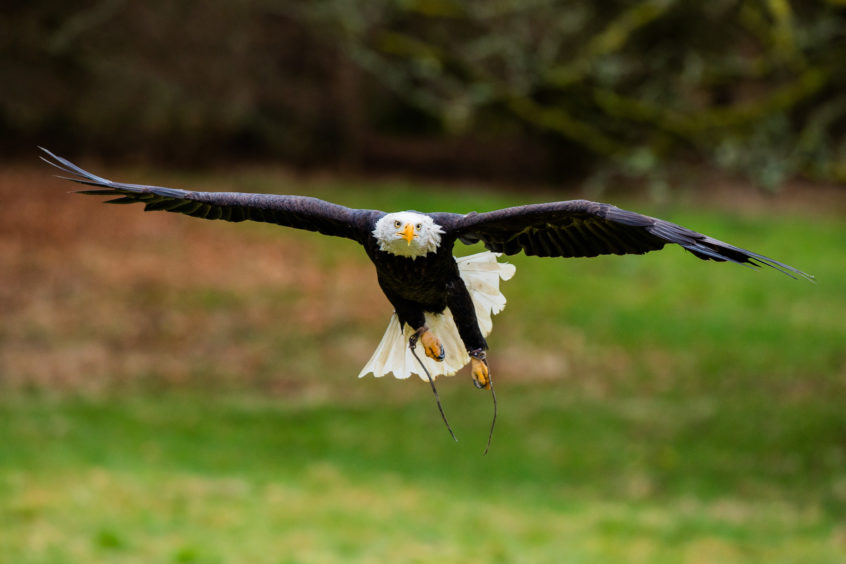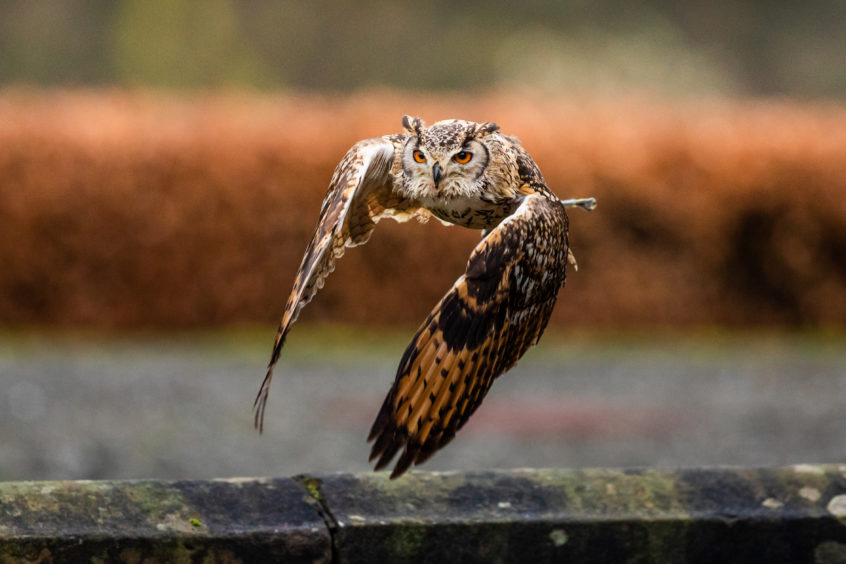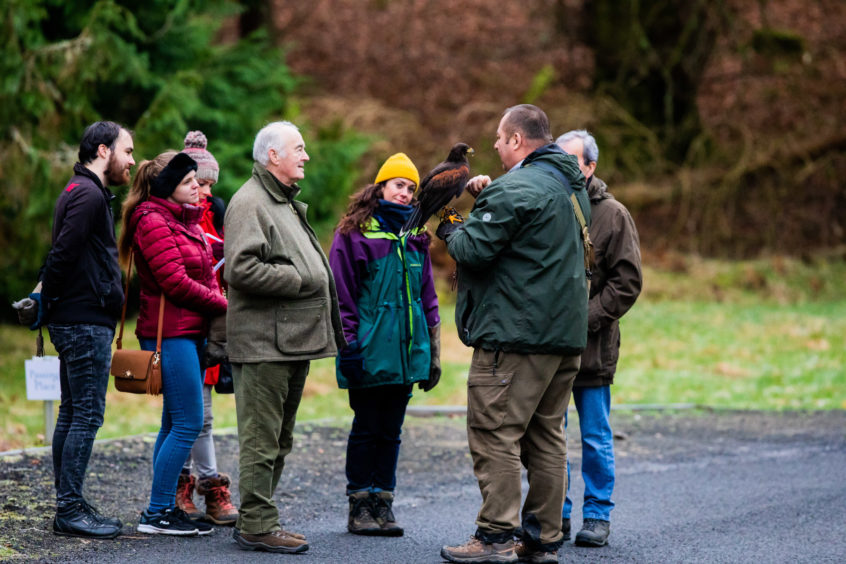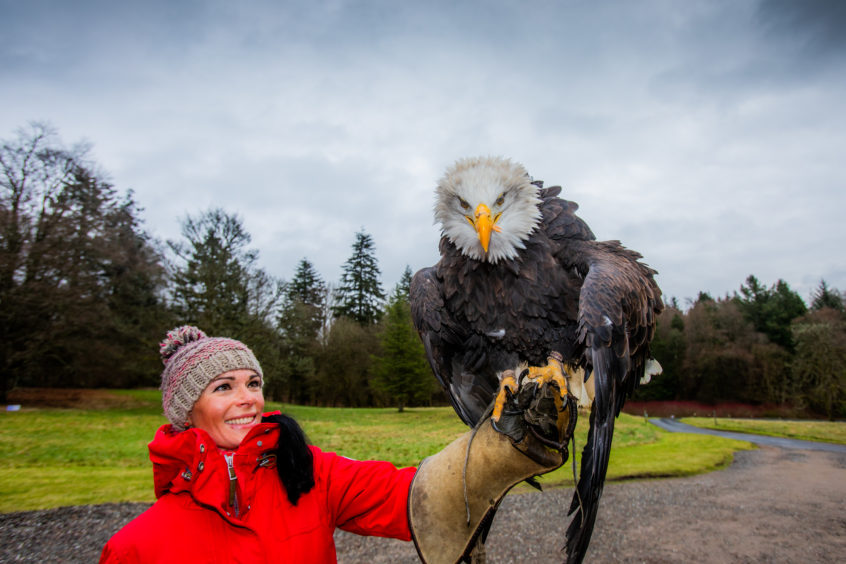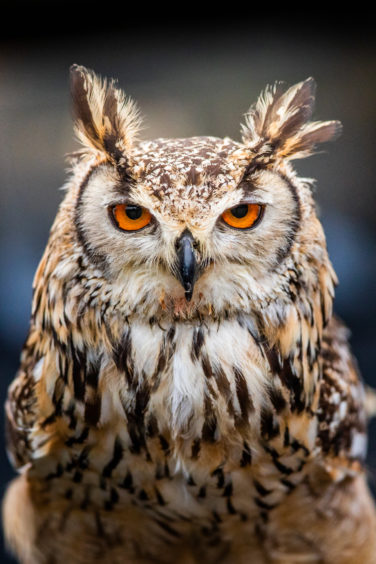Eagles, owls, hawks, buzzards and falcons – they are the undisputed kings and queens of the sky. Gayle enjoys an exhilarating bird of prey experience
An imperious-looking bald eagle is perched on my fist, devouring the entrails of a (dead) day-old chick.
I’m rather intimidated by this fearsome fellow, with his hooked yellow beak and razor-sharp talons which I can well imagine sinking into their unsuspecting prey…
Despite my apprehension, it’s a huge honour to be up close and personal with this amazing winged predator.
I’m in the grounds of Cromlix Hotel near Dunblane taking part in a unique bird of prey experience run by Phoenix Falconry.
The company boasts a staggering 170 raptors including hawks, eagles, eagle owls and buzzards.
Head falconer and top breeder Adrian Hallgarth brims with knowledge and his enthusiasm is infectious.
After talking through some basics, Adrian turns to me with a furrowed brow.
“Could you remove the fur collar of your jacket, please?” he asks. “The birds might take a fancy to it”! Heck, I practically rip the thing off!
The first bird we’re introduced to is Caine, a 23-year-old Harris Hawk, native to South America.
“These birds have an uncanny ability to get through tiny spaces by elongating their bodies,” quips Adrian, before getting me to put my hands on my hips and then inviting Caine to fly through one cocked elbow. Wow.
As we walk through the woods, Caine is never far behind, although some of his landings on unstable branches are a little clumsy.
Stopping in a clearing, Adrian places a piece of dead chick into the leather gauntlet I’m wearing and asks me to hold it up. I’m elated when Caine flies to me and gobbles it down.
As I’m oohing and aahing over the sheer majesty of the hawk, Adrian tells me Caine likely views me as a “McDonald’s Drive-Thru”!
Is there a chance he might consider plucking out an eye, I wonder?
Adrian chuckles: “They never use their beaks so you’re quite safe. They’ve not been taught to do that, so why would they? It’s not their beaks you want to watch out for – it’s their talons. They’re proper killing tools.”
The next bird is Pilgrim, the huge, scary-looking bald eagle.
This bad boy has starred in an ice cream advert, was mascot for the American Ryder Cup team and featured in the Gleneagles advert for the event. In fact, many of Adrian’s birds have graced the screens, featuring in everything from Microsoft and motoring adverts to award-winning films.
As Pilgrim, who boasts a wing span of 7ft, is soaring through the sky, Adrian notices something is up. Turns out he isn’t keen on a fellow group member’s yellow hat, which she promptly removes.
Soon, it’s my turn to fly him. Adrian pops a dead chick into my fist and Pilgrim speeds towards me, landing deftly and tearing his dinner to shreds. He weighs 10lbs and very quickly, that 10lbs start to feel very heavy.
Things get even more exciting when Adrian brings out Keiller, a 63-year-old Himalayan Eagle Owl.
Keiller has asymmetrically-set ear openings (one higher than the other) and a pronounced facial disc which acts like a “radar dish” guiding sounds into the ears.
“His heart-shaped face is the secret to his success,” says Adrian.
“He can hear the heartbeat of a mouse 400m away. But there’s a price to pay – he has a tiny brain! Sorry folks – there’s no such thing as a wise old owl!”
There is such a thing as a hungry owl, though, and we watch as Keiller swallows a chick whole.
“That’s nothing!” whoops Adrian. “I’ve seen him swallow a three-quarter rabbit.”
It’s not the nicest of ways to die. Owls swallow prey live and it suffocates in their trachea.
When I express surprise that Keiller is 63, Adrian tells me that many birds can indeed live well into their 80s.
“That crow you see hopping past your window? He could be in his 50s!” he beams.
“Seagulls also live into their 80s. But for some reason, people don’t think birds live that long.”
Next up is Evil Edna, a striated caracara, the most intelligent bird in the world.
“They have no natural enemies, eat all kinds of stuff including penguin carcasses, have a strong bite and can run at 25mph on the ground,” says Adrian.
“They’re also big thieves and hoarders. Troop members’ underpants and ammunition were found in their nests after the Falklands War! They kill other birds and unfortunately, Edna killed one of mine. She can pick locks so her chamber needs three!”
The final bird of the day is eight-month-old peregrine falcon, Bonus. The breed is among the fastest in the world, reaching speeds of 220mph. They’re hugely expensive to buy and have exceptional vision – they can spot a pheasant’s wing two-and-a-half miles away.
Most of Adrian’s birds are hand-reared in captivity and live with him and his family for the first few weeks of their lives.
“They grow up with us in the house like kittens!” he smiles. “I’ll be watching TV, minding my own business, when my foot gets attacked by a baby falcon! They live with us until they can fly but it’s hard work! You can’t put corks up their backsides!”
While the bond between Adrian and his birds is strong – he kisses them and talks about them as if they’re his kids – no bird of prey can ever truly be tamed.
The best a falconer can achieve is a working partnership, accepting that although the bird will tolerate handling and hunting with – but not for – him or her, it will revert to a wild state in the blink of an eye.
They’re trained through a combination of intensive appetite management and acclimatisation to living and working with humans. Ultimately, the birds shouldn’t want to leave because they associate all positive things in life with Adrian and his team.
Have any of the birds ever flown off and never come back? Thankfully, no, says Adrian.
But there have been a few incidents! In 2011, Pilgrim was chased by wild buzzards and disappeared for days. A few years later, he got stuck at the top of an electricity pylon and had to be rescued by firefighters.
When it comes to artificial insemination, Adrian often gets semen sent via racing pigeon from Hexham!
“It takes two hours to reach Perthshire – quicker than the postie!” he chuckles!
In 2017, one of Adrian’s superfast racing falcons won more than £100,000 in prizes for its Middle East owners and trainers.
As well as the prize money, the value of the bird soared, and successful falcons have been known to change hands for millions of dollars.
Adrian, 50, has been passionate about birds of prey his entire life.
“I fell in love with the idea after reading a falconry book,” he recalls.
“It was a choice between horses or birds of prey. Dad wisely thought birds would be a cheaper hobby!”
He was eight when he got his first bird, a kestrel, and progressed to a sparrow hawk with which he went hunting for small birds. In his teens, he flew a goshawk and came back with food for the table – ducks, hares and partridges.
The hunting side of falconry might not appeal to everyone but Adrian believes it’s a “noble” sport that should be kept alive.
As such, Phoenix Falconry offers “natural hunting” experiences from September to December.
The company is in the process of shifting its headquarters to Airth and it’s hoped this will be ready by the end of this year. Until then, experiences will run from Cromlix Hotel.
For more details, see www.scottishfalconry.co.uk
